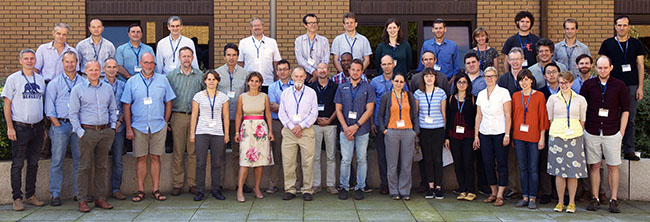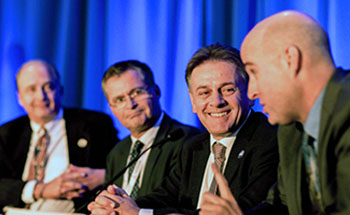A busy week for the GMAO
09.23.2016
In NASA's Global Modeling and Assimilation Office, all weeks are busy — but some weeks get busier than others! The week of September 12-16 was action-packed, with GMAO staff engaged in numerous activities that help us maintain and expand our mission, use our data in different applications, and engage with the broader scientific community.
Aircraft Field Missions
At any time, GMAO may be supporting several NASA aircraft missions by providing analyses and forecasts of meteorological fields and pollutants. In the week of September 12-16, GMAO's products were being used by two NASA field missions: the CARbon Airborne Flux Experiment (CARAFE), based at NASA Wallops in Virginia, and the ObseRvations of Aerosols above CLouds and their intEractionS (ORACLES) mission, based in Walvis Bay, Namibia. ORACLES is a NASA Earth Venture Suborbital project, using the P-3 and ER-2 aircraft. Arlindo da Silva of the GMAO is on the ORACLES Science Team and, along with Karla Longo, is spending time in the field, using the GEOS aerosol forecasts for flight planning purposes.

Photo: A briefing in the ORACLES Operations room in Swakopmund, Namibia. From left to right around the U shaped table, the photo shows: Lenny Pfister (NASA Ames), Arlindo da Silva (GMAO), Greg Carmichael (University of Iowa), Paquita Zuidema (University of Miami), Sarah Doherty (University of Washington) Greg McFarquhar (University of Illinois), Rob Wood (University of Washington), and the ORACLES PI, Jens Redmann (NASA Ames). Photo Credit: Danitza Klopper, North West University, South Africa.
Collaborations and Discussions
GMAO entertained two visitors this week. Hongyu Liu, based at NASA Langley Research Center, visited to discuss an ongoing collaborative project with his GMAO partner, Donifan Barahona. Hongyu's visit was in connection with the Science Innovation Fund (SIF) project: “Aerosol-Cloud-Climate Modeling to Drive Future Earth Observing Systems.” At GSFC, he set up some simulations that cover the period of the North Atlantic Aerosols and Marine Ecosystems Study (NAAMES) field campaign (November 2015). These runs will serve as the basis for the next stage of the project, using aerosol and cloud information collected in the field to drive the two-moment microphysics module in GEOS-5.
On Tuesday September 13, the speaker at GMAO's Seminar Series on Earth System Science was Rob Kursinski, Chief Scientist from Space Sciences and Engineering LLC, in Louisville, Colorado. Rob's presentation, “The Future is Now. ATOMMS: A New Radio Occultation System at cm and mm Wavelengths for Weather and Climate,” led to detailed conversations with several GMAO staff members. This included a long group discussion, with Ron Errico, Ron Gelaro, Dan Holdaway, Will McCarty, and Steven Pawson, about a possible collaborative study using the GEOS Observing System Simulation Experiment (OSSE) framework.
At NASA's Jet Propulsion Laboratory (JPL) on Thursday September 15, Steven Pawson presented a seminar entitled “Progress toward an Earth System Modeling and Analysis Capability in the GMAO.” This covered material from a broad range of GMAO's activities, from weather to climate research, touching especially on the use and impact of NASA observations. The visit also included fruitful meetings with a number of JPL staff.
A discussion meeting between several GMAO staff and members of NASA's AIRS mission took place in Greenbelt, MD, on Friday September 16. Headed by João Teixeira (Project Scientist) and Tom Pagano (Project Manager) from JPL, the AIRS team also included Eric Fetzer, Larrabee Strow and Chris Barnet. Will McCarty, Isaac Moradi, Steven Pawson, Nikki Prive, Kris Wargan, and Brad Weir represented GMAO at the meeting. The conversation revolved around potential collaboration between the two teams, including enhancing the use of infrared radiance datasets from AIRS in future GEOS products, such as the value of long, stable time series for reanalyses, the use of high-peaking 15 micron radiances to constrain the stratosphere, and the potential value of data assimilation in deriving trace-gas distributions from AIRS data. Other topics included the collaborative use of OSSEs, as JPL seeks to develop new instrument concepts.
Workshops and Conferences
Participation in workshops is an effective means of both disseminating experience gained in the GMAO and of learning from the experiences of other groups. Matt Thompson and Nathan Arnold traveled in opposite directions to attend different workshops. A visit to the European Centre for Medium-Range Weather Forecasts (ECMWF) gave Nathan an opportunity to share information about GMAO's work at the “Workshop on Drag Processes and their Links to the Large-Scale Circulation.” The paper (by Molod, Takacs, and Arnold) examined the impacts of changing three types of surface drag (ocean-surface roughness, vegetation-surface roughness, and topographic form drag) on forecast skill in the GEOS model, demonstrating more beneficial impacts in the Northern Hemisphere than in the Southern Hemisphere.
The “2016 MultiCore 6 Workshop” at the National Center for Atmospheric Research (NCAR) in Boulder, Colorado, allowed Matt to focus on some of the computational challenges in developing computer models that run on modern architectures. Topics spanned the use of existing computer architectures, such as GPUs, and forward-looking approaches as we approach Exascale computing capabilities.

Photo: Group photograph taken at the “2016 Multicore 6 Workshop” in Boulder, Colorado. Matt Thompson is at the right-hand end of the second row. Photo by AJ Lauer, NCAR (used with permission). Copyright © 2016 University Corporation for Atmospheric Research. All Rights Reserved.

Photo: Group photograph taken at the “Workshop on Drag Processes and their Links to the Large-Scale Circulation” in Reading, England. Nathan Arnold is at the right-hand end of the middle row. Photo credit: ECMWF (used with permission).
GMAO was well represented at NASA's annual “Sounder Science Team” in Greenbelt, MD. Will McCarty gave two presentations. The first was an overview of the use of infrared sounder information in the GEOS data assimilation system (DAS). The second used quantitive, adjoint-based metrics to examine the forecast sensitivity to the use of infrared radiances in the GEOS DAS. Isaac Moradi presented a study on the intercalibration of microwave humidity measurements made with different sounders. Oreste Reale presented two papers addressing different aspects of assimilating infrared radiance data in the GEOS DAS. The first examined the issue of observational thinning of cloud-cleared radiance; the second compared the impacts of data from three different instruments (AIRS, IASI and CrIS) on the representation of tropical cyclones in the GEOS analyses. Last, but not least, Richard Cullather demonstrated the use of infrared sounder data in his joint study of the warmest winter ever observed in the Arctic: 2015-2016.
Steven Pawson attended two different conferences this week. On Monday September 12, he was at the “Conference on Geospatial Approaches to Cancer Control and Population Sciences” at the Natcher Conference Center on the NIH campus in Bethesda, MD. He presented a jointly authored poster entitled “Global mapping of satellite observations to provide space-time maps of air pollution.” He was able to meet potential collaborators from the epidemiology community who may have applications for air pollution datasets derived from the assimilation of NASA's satellite observations. On Wednesday September 14, he attended the American Institute of Aeronautics and Astronautics (AIAA) SPACE2016 annual meeting in Long Beach, CA. At this meeting, he served on a Forum360 panel. These panels offer engaging conversations with experts covering a spectrum of timely topics including programs, systems, policy, operations, applications, platforms and more. The theme of the discussion was “Earth Observations — Space and the Paris Agreement” which focused on the challenges in implementing the Paris Agreement and the potential role that space-based capabilities can play in achieving the aims of the Paris Conference. The panel included Phil de Cola (Sigma Space), Jean Pascal le Franc (CNES) and Riley Duren (JPL) and moderated by Randall Friedl (JPL).


Photos: Two photos of the panel discussion at the AIAA Meeting. The left-hand photo shows Randy Friedl as he leads the discussion and the right-hand photo shows Phil de Cola, Jean Pascal le Franc, Steven Pawson and Riley Duren. Photos by the AIAA and used with permission.
Planning Meetings
Two GMAO members, Randal Koster and Lesley Ott, are serving on panels related to the new Earth Science and Applications from Space (ESAS) Decadal Survey. On September 15-16, 2016, scientists on various panels met in Washington, D.C., to discuss their findings and recommendations in the context of potential “integrated themes” — themes that span the recommendations and thus may serve as an additional organizational framework. Randal Koster attended this meeting as a representative of the “Climate Variability and Change: Seasonal to Centennial” panel. Lesley Ott was a representative of the “Terrestrial and Marine Ecosystems” panel.
Lesley Ott also participated in an OSTP-coordinated meeting at the USGCRP headquarters in Washington, DC, on September 15. The purpose of this meeting was to begin drafting an interagency plan for enhanced greenhouse gas monitoring and analysis capabilities.

